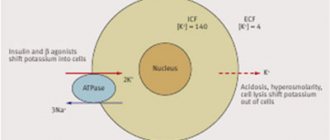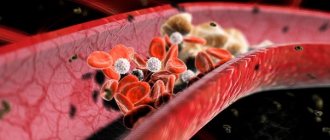General information about atherosclerosis
A constant increase in the level of cholesterol and other lipids in the blood leads to their penetration and accumulation in the walls of arteries in places where they are subject to heavy pressure load (aorta, coronary vessels, brain arterioles, vessels of the lower extremities and intestines). This leads to a narrowing of the lumen of the arteries and disruption of the blood supply to organs. Blood flow is hampered by both the atherosclerotic plaque itself and the blood clots that appear in these places. This process is especially dangerous for the heart and brain.
Classification of atherosclerosis
Depending on the location of the pathological process, atherosclerosis of the aorta, coronary vessels, cerebral vessels, renal arteries, arteries of the lower extremities, and mesenteric (blood supplying the intestines) vessels are distinguished.
Clinical forms of atherosclerotic vascular lesions:
- coronary heart disease (angina pectoris, myocardial infarction, cardiosclerosis, arrhythmias, heart failure);
- aneurysms;
- cerebrovascular accident (stroke);
- arterial hypertension (increased blood pressure above 140/80);
- thrombosis of mesenteric vessels;
- ischemic damage to the lower extremities (intermittent claudication, gangrene);
- atherosclerosis of the renal arteries with the development of hypertension.
Mechanism of development of atherosclerosis
The main role in the pathogenesis of the disease is played by an imbalance between blood lipid fractions. With a decrease in the level of high-density lipoproteins (found in vegetable fats, fish, seafood, cheese) and an increase in high-density lipoproteins (animal fats), the latter are deposited in the wall of blood vessels. This is preceded by local damage to the inner wall of the arteries. Smoking, low levels of antioxidants, and certain viruses and bacteria play a role in this.
Stages of development of atherosclerotic disorders:
- Lipid spot stage
. The plaque does not rise above the level of the vessel wall, does not manifest itself clinically, and is not determined by any research methods during life. - Stage of liposclerosis
. Connective tissue fibers grow into the lipid mass. This makes the plaque more dense, it protrudes into the lumen of the vessel and impedes blood flow in this area. - Stage of atherocalcinosis
. Foci of calcification appear in the plaque and salts are deposited. The plaque completely hardens and is not subject to reverse development. This is where ulceration of the plaque and blood clotting in the vessel begins, which leads to thrombosis.
Risk factors for the development of atherosclerosis
All factors that can lead to the development of atherosclerotic lesions can be divided into 3 groups: controllable (we can influence them), uncontrollable and relatively controllable.
Controllable risk factors:
- a diet rich in animal fats, trans fats, insufficient consumption of plant foods;
- smoking;
- sedentary lifestyle.
Uncontrollable risk factors:
- heredity;
- age over 55 years;
- male gender.
Relatively controllable factors
ー chronic diseases that lead to metabolic disorders. They cannot be cured, but can be controlled with diet and medication. These include type 2 diabetes mellitus, hypertension, obesity, and severe infectious diseases (for example, tuberculosis).
On double target
The above-mentioned new class of anti-sclerotic drugs acting at the gene level includes substances that activate the so-called PPARs - special cellular receptor proteins. PPARs are transcription factors
: they “turn on” the work of certain genes, stimulating the production of corresponding proteins involved in the regulation of the most important physiological processes, including lipoprotein metabolism.
There are three forms of these receptor proteins - α, β and γ, and each of them is activated by its own specific compound ( agonist
) – for example, fatty acids or prostaglandins involved in the anti-inflammatory response. Each form regulates different, although overlapping, cascades of biochemical processes. For example, PPARα “activators” affect lipoprotein metabolism and are used to treat lipid metabolic disorders; PPARγ activators involved in glucose metabolism – for the treatment of type 2 diabetes.
It has long been known that patients with atherosclerosis often develop diabetes and have problems with lipid and carbohydrate metabolism in general. Therefore, recently there has been great interest in the creation of drugs based on double (α and γ) glycazars - tezaglitazar, ragaglitazar
) and even triple agonists of these receptors.
Research has shown that even small changes in the chemical structure of PPAR agonist compounds dramatically affect their ability to selectively bind to the target, which means that the pharmacological properties of such substances can vary greatly - because in this way we interfere with very subtle processes of metabolic regulation.
In general, this class of anti-atherosclerotic substances looks very promising, since they work in significantly lower doses than statins: after all, significantly fewer molecules are required to send a signal through relatively few receptors than to inhibit a large number of enzyme molecules. Hence the significantly lower toxic load on the body: tens to hundreds of times less than for statins, and thousands of times less than for conventional hypoglycemic drugs.
Symptoms of atherosclerosis
Atherosclerotic damage to the arteries does not manifest itself until a significant narrowing of the lumen of the vessels occurs. Thus, the disease may not manifest itself even with 75% occlusion of the artery (if compensatory mechanisms operate at normal levels). Also, the symptoms of the disease depend on the location of the lesion:
- pressing, burning pain behind the sternum with irradiation to the left arm, scapula with damage to the coronary arteries;
- hypertension (high blood pressure), if the process is concentrated in the aorta or renal arteries;
- abdominal pain, bloating, flatulence, frequent constipation when the plaque is localized in the mesenteric arteries;
- deterioration of memory, attention, intelligence, mental disorders, sleep disturbances due to damage to the blood vessels of the brain;
- intermittent claudication (a person stops to soothe the pain in the leg while walking), coldness of the limb, loss of sensitivity, a sensation of “pins and needles” when the blood vessels of the leg are damaged.
Bibliography
When compiling this article, we deliberately simplify some of the material so that it is understandable for non-specialists. If you are a doctor, we will be happy to answer your questions. Write or call us to discuss details. To prepare this material, the following publications were used:
- Girard JP, Moussion C., Forster R. HEVs, lymphatics and homeostatic immune cell trafficking in lymph nodes. Nat. Rev. Immunol. 2012;12:762–773. doi: 10.1038/nri3298.
- Randolph GJ, Miller NE Lymphatic transport of high-density lipoproteins and chylomicrons. J. Clin. Investig. 2014;124:929–935. doi:10.1172/JCI71610.
- Aspelund A., Robciuc MR, Karaman S., Makinen T., Alitalo K. Lymphatic System in Cardiovascular Medicine. Circ. Res. 2016;118:515–530. doi: 10.1161/CIRCRESAHA.115.306544.
- Alitalo K., Tammela T., Petrova TV Lymphangiogenesis in development and human disease. Nature. 2005;438:946–953. doi: 10.1038/nature04480.
- Moore KJ, Sheedy FJ, Fisher EA Macrophages in atherosclerosis: A dynamic balance. Nat. Rev. Immunol. 2013;13:709–721. doi: 10.1038/nri3520.
- Rademakers T., van der Vorst EP, Daissormont IT, Otten JJ, Theodorou K., Theelen TL, Gijbels M., Anisimov A., Nurmi H., Lindeman JH, et al. Adventitial lymphatic capillary expansion impacts on plaque T cell accumulation in atherosclerosis. Sci. Rep. 2017;7:45263. doi: 10.1038/srep45263.
- Milasan A., Ledoux J., Martel C. Lymphatic network in atherosclerosis: The underestimated pathway. Future Sci. O.A. 2015;1:FSO61. doi: 10.4155/fso.15.61.
- Camare C., Pucelle M., Negre-Salvayre A., Salvayre R. Angiogenesis in the atherosclerotic plaque. Redox. Biol. 2017;12:18–34. doi: 10.1016/j.redox.2017.01.007.
- Randolph GJ Mechanisms that regulate macrophage burden in atherosclerosis. Circ. Res. 2014;114:1757–1771. doi: 10.1161/CIRCRESAHA.114.301174
- Johnson RA Lymphatics of blood vessels. Lymphology. 1969;2:44–56.
- Drozdz K., Janczak D., Dziegiel P., Podhorska M., Patrzalek D., Ziolkowski P., Andrzejak R., Szuba A. Adventitial lymphatics of internal carotid artery in healthy and atherosclerotic vessels. Folia Histochem. Cytobiol. 2008;46:433–436. doi: 10.2478/v10042-008-0083-7.
- Kutkut I., Meens MJ, McKee TA, Bochaton-Piallat ML, Kwak BR Lymphatic vessels: An emerging actor in atherosclerotic plaque development. Eur. J. Clin Investig. 2015;45:100–108. doi: 10.1111/eci.12372
- Xu X., Lin H., Lv H., Zhang M., Zhang Y. Adventitial lymphatic vessels—An important role in atherosclerosis. Med. Hypotheses. 2007;69:1238–1241. doi: 10.1016/j.mehy.2007.04.007.
- Martel C., Randolph GJ Atherosclerosis and transit of HDL through the lymphatic vasculature. Curr. Atheroscler. Rep. 2013;15:354. doi:10.1007/s11883-013-0354-4.
- Huang LH, Elvington A., Randolph GJ The role of the lymphatic system in cholesterol transport. Front. Pharmacol. 2015;6:182. doi: 10.3389/fphar.2015.00182.
- Csányi G, Singla B. Arterial Lymphatics in Atherosclerosis: Old Questions, New Insights, and Remaining Challenges. J Clin Med. 2019;8(4):495. Published 2021 Apr 11. doi:10.3390/jcm8040495
- Levin Yu.M. Fundamentals of therapeutic lymphology. - M.: Medicine, 1986. - 288 p., ill.
Diagnosis of atherosclerosis
All patients with signs of atherosclerosis need consultation with a cardiologist or cardiovascular surgeon; after a physical examination, the patient is prescribed such tests and diagnostic procedures;
- clinical and biochemical blood tests to determine the level of cholesterol and other lipids;
- Ultrasound of the heart with Dopplerography (ECHO Cardiography);
- Dopplerography of blood vessels (examination of blood flow using ultrasound);
- arteriography (x-ray examination with the introduction of a contrast agent into the vessels of interest);
- Ultrasound of the kidneys and abdominal organs;
- rheovasography of the lower extremities (determining the sufficiency of blood flow).
Which specialist should you contact?
First of all, a person suffering from these symptoms should visit a general practitioner (general practitioner or family doctor). He will be able to draw up a clinical picture and, in the case of early stages, recommend treatment, including changes in diet, lifestyle, vitamin therapy, and the use of medications.
In the case of later stages of the disease, based on the described signs, the therapist will refer the patient to a doctor of narrow specialization - a neurologist.
The neurologist will prescribe a detailed examination on an outpatient or inpatient basis. After this, the primary diagnosis will be confirmed.
If abnormalities in the lipid spectrum are detected, a consultation with a nutritionist will be scheduled.
Often cerebral atherosclerosis is accompanied by weight gain and signs of diabetes mellitus. In this case, a conversation with an endocrinologist will be prescribed.
If the examination reveals a plaque that interferes with normal hemodynamics, then a consultation with a vascular surgeon will be needed regarding surgical treatment methods.
Forecast and prevention of atherosclerosis
The prognosis for a person with atherosclerosis is mixed. If he adheres to the doctor’s recommendations (diet, quitting smoking and alcohol, drug treatment), then the prognosis is favorable, and the growth of plaques can be slowed down. For patients who do not heed these recommendations, the picture is sadder: the risk of myocardial infarction and stroke increases significantly.
Basic preventive measures:
- less animal fats, more vegetable oils;
- sufficient amount of vitamins and microelements;
- to give up smoking;
- limiting alcohol consumption;
- physical activity, normalization of body weight;
- avoidance of emotional stress and worries.
Diagnosis and treatment of atherosclerosis in Medical
When should you see a doctor?
If the described symptoms appear, you should consult a cardiologist. Also, if there are risk factors, a preventive examination is recommended once a year.
You should not treat atherosclerosis using traditional methods! There are no traditional medicines that would help dissolve atherosclerotic plaques, and medications should be taken only in the dosage prescribed by the doctor.
Drug treatment
Patients with atherosclerotic artery disease are prescribed drugs that lower blood cholesterol levels, antihypertensive, antithrombotic, vitamin and antioxidant complexes.
Surgery
The main goal of surgical treatment is to restore blood flow in tissues. This can be achieved by widening the narrowed artery (installation of a stent), creating a collateral blood supply (bypass surgery).
Coronary artery bypass grafting
The principle of the method is to create an additional vessel between the aorta and the area of the affected coronary artery beyond the plaque. To do this, a section of the saphenous vein is taken from the patient’s lower leg.
Victory is for nature
Researchers continue to search for more effective and safe natural substances with a statin-like structure, and are also trying to synthesize new compounds with the desired properties.
However, on this path they encounter considerable difficulties. First, it turned out that the synthesis of the lactone fragment, which determines the therapeutic effect of the compound, is a technically challenging task. Secondly, although quite a lot of purely synthetic drugs have been obtained for the treatment of hyperlipidemia ( fluvastatin, atorvastatin, cerivastatin
), they are not superior in therapeutic properties to the well-known compactin and mevinolin, which are today obtained biotechnologically.
That's why mevinolin is still called lovastatin
continues to be used in medical practice, and the leader of the pharmacological market is the drug
ineji
- a combination of the closest analogue of mevinolin,
simvastatin,
with ezetimibe. The record for effectiveness was broken by the natural compound FR901512, recently isolated from the same molds (Inoue and Nakada, 2007).
Nevertheless, the process of searching and creating new synthetic statin drugs does not stop. Currently, drugs are being developed that are fundamentally different from natural ones: the lipophilic part of the molecules of these compounds contains polar fragments, which, when interacting with the enzyme, change its conformation (shape). This new type of interaction ultimately allows for greater cholesterol synthesis inhibition.
It is possible to influence the conformation of the enzyme and ensure better fixation of the statin in its active center using other methods. A similar effect is achieved, for example, when using a complex of simvastatin and atorvastatin with glycyrrhizic acid, which is obtained from the roots of licorice (Tolstikov et al., 2006; 2008).






